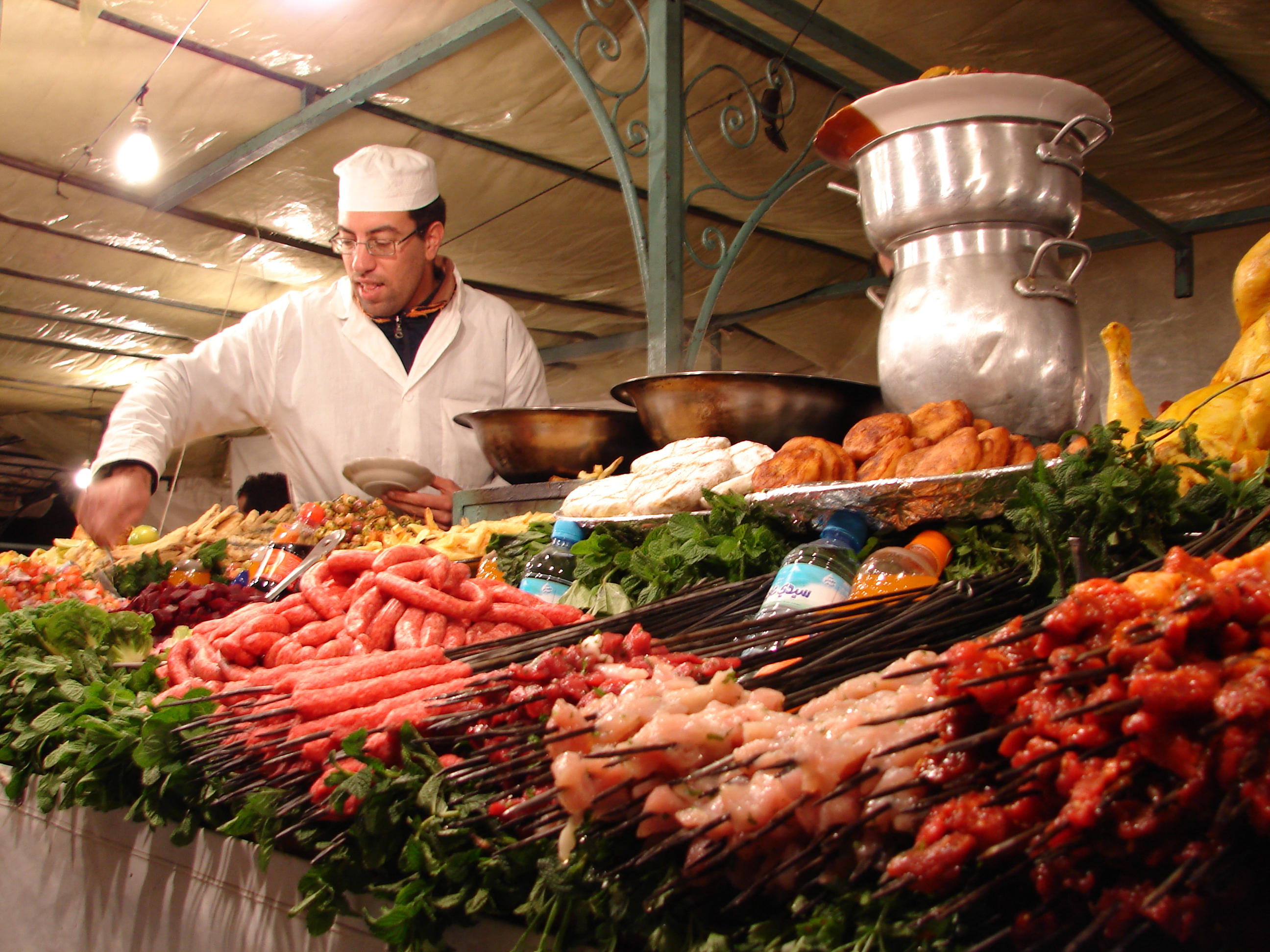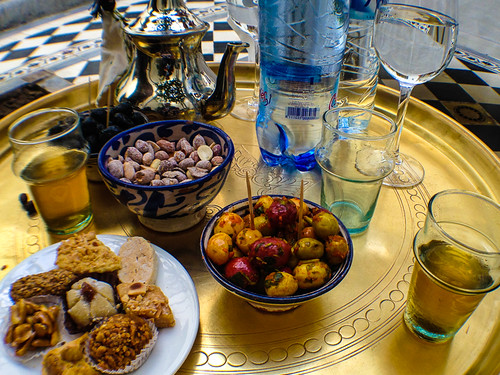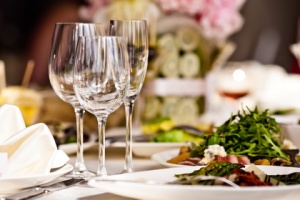Chinese Food Cultural Profile
The phrase is a testament to the popularity of Chinese food around the world. Food is an important part of daily life for Chinese people. Chinese not only enjoy eating but believe eating good food can bring harmony and closeness to the family and relationships.
Shopping daily for fresh food is essential for all Chinese cooking. Unlike the fast food society of the U.S., the Chinese select live seafood, fresh meats and seasonal fruits and vegetables from the local market to ensure freshness. This means swimming fish, snappy crabs, and squawking chickens. Even prepared foods such as dim sum or BBQ duck for to go orders must gleam, glisten, and steam as if just taken out of the oven.
Chinese people in general are not as concerned about nutrition as Western culture. They are more concerned with the food's texture, flavor, color, and aroma. These are the crucial points for good Chinese cooking. Chinese daily meals consist of four food groups: grains, vegetables, fruit, and meat. Because of lactose intolerance, Chinese do not consume large amounts of dairy products. Instead, Chinese substitute these with soymilk and tofu, which also contain large amounts of protein and calcium. Vegetables, fruits, and meats are usually fresh. Some exceptions include preserved vegetables such as snow cabbage or mustard greens, preserved eggs, aka "thousand year old eggs" or salted and dried fish. Other exceptions include snack items such as beef jerky, cuttlefish jerky, sweet and sour preserved plums, or dehydrated mango slices. Canned or frozen foods are seldom eaten. Western desserts such as cookies, cakes, pies, and ice cream are eaten only on special occasions such as birthdays and weddings. After dinner, families usually eat seasonal fruit as dessert. Chinese desserts such as red bean soup, sweet white lotus's seed soup, or steam papaya soup are served every so often as a special treat on a hot summer's night.
Ethnic Chinese cooking does not involve a lot of deep fried cooking. The reason most of the Chinese restaurants in America have deep-fried dishes such as sweet and sour pork, almond fried Chicken, and deep-fried shrimp is to promote business and to please western tastes. This clearly reflects why there are more overweight and high blood pressure concerns in Western culture than there are in Chinese culture.
"Yi xing bu xing"
Chinese hardly waste any section of the animal and have found ways to cook nearly every part. Chinese culture believes that "yi xing bu xing," which means by using any shape or part of the animal the same part of the human body can be replenished and strengthened. For example, shark fin soup and bird nest soup (bird's saliva) is served to replenish strength and increase appetite, crocodile meat strengthens the bronchia, dehydrated tiger testicle increases stamina for men, while monkey brains add wisdom. These foods are considered to be delicacies and tonics. Shark fin soup or bird nest soup is often served at special occasions such as at a Chinese banquet dinner. Other items are rarely prepared.
The Chinese banquet
The Chinese banquet dinner usually occurs on special occasions like holidays, weddings, graduations, birthdays, or having a special visitor in town. It's an event for family and friends to get together for fellowship and laughter. There are usually 10 guests that sit around each table. The banquet dinner involves 10 to 12 dishes including appetizers like jellyfish salad or vinegar pork shank and soups like shark fin, bird's nest, or fish lining. Main courses served at the banquet include lobster, crab, steamed fish, shrimp, abalone, sea cucumbers, quail, crocodile meat, duck, lamb, beef, chicken, and seasonal vegetable dishes and fresh fruit or sweet soup for dessert.
Regional Cuisine
There are many different cuisines in China. Each province has its own special style of cooking. There is Beijing cuisine, Hunan or Hubai cuisine, Shanghai cuisine, Szechwan cuisine, Cantonese cuisine, Hakka cuisine1, etc. The most well known cuisines are Szechwan and Cantonese. The Szechwan cuisine has the spiciest dishes. They use a lot of chili paste, red pepper, and hot oil in their food. The most famous Szechwan dishes are hot chili eggplant, twice-cooked pork, Szechwan beef, Ma Po Tofu, and Kung Pau Chicken. These dishes are all very spicy and delicious.
The Cantonese cuisine is the most well known cuisine in the Chinese community2. In fact, in China, they say, "Eating is in Canton." Cantonese people are known to be quite particular and have high expectations about their food. All the vegetables, poultry, and ingredients have to be fresh. The timing on the cooking is very crucial. Dishes must not be overcooked, and the texture of the food has to be just right with the freshness and tenderness still remaining. For this reason, Cantonese food is very popular. Soup is also essential in Cantonese cuisine. It consists of different ingredients and herbs and is boiled to a rich and tasty soup before it is served. There are many kinds of soup and each soup has it's own function or purpose. Cantonese women believe that "to win a man's heart, she must first learn how to cook a good pot of soup."
Yin Yang foods
As mentioned before, due to geographical and climate differences in China, each area has its own way of cooking and different eating habits. Northern China has cold and damp weather, and therefore people there eat more hot and spicy foods such as chilies, onions, and garlic. They believe these foods will increase blood circulation and help get rid of the coldness and dampness. Generally people from the south like to eat more mild and cooling foods because of the warmer climate. These foods reduce the hotness and dryness. This theory is called balancing "Yin and yang".
Chinese culture believes there is a positive energy and a negative energy in the universe. "Yin" represents negative energy and "yang" represents positive energy.3 They have to be equally balanced to create a harmonious and healthy state, otherwise, conflict and disease will be created. There are elements that belong to both "yin" and " yang," meaning some elements of yin fall within yang and some elements of yang fall within yin. This importance of balancing forces has been a part of Chinese thought for thousands of years. It has become a basic guideline for social, political, medical, and dietary usage.
Foods belonging to the yin (also known as "cold" food) are bitter melon, winter melon, Chinese green, mustard green, water crest, Napa cabbage, bean sprout, soybean, mung bean, tulip, water chestnut, cilantro, oranges, watermelon, bananas, coconut, cucumber, beer, pop, ice cream, ice chips, grass jelly, clams, and oysters. These foods cannot be eaten excessively and are thought to cause stomachaches, diarrhea, dizziness, weakness, and coldness in the body if done so.
Foods that belong to the yang (also known as "hot" food) are chili pepper, garlic, onion, curry, cabbage, eggplant, toro, pineapple, mango, cherry, peanuts, beef, turkey, shrimp, crab, French fries, fried chicken, and pizza. Excessive intake of these foods are thought to cause skin rashes, hives, pimples, nose bleeds, gas, indigestion, constipation, redness in the eyes, and sore throat. Both food groups need to be balanced evenly, not taken excessively or deficiently in order to create a harmonious and healthy state.
Because Illness is thought to be related to an unbalance that can be influenced with dietary intake. Often, a Chinese patient may ask the provider questions such as "is there any thing that I should not eat'? Typically, Western provider will only limit food for certain illness, such as sugar intake for diabetes, or salt and fat consumption for hypertension or heart problems. However, because of the conceptual framework around health and balance of the yin and yang, the patient may expect advice on how to avoid aggravating the illness. The patient is really asking" Doctor, because of my illness, should I watch out for certain foods? Which foods will throw off my balance even more?" For example, certain foods in the Chinese culture are asserted to be toxic or poisonous to individuals with weakened health. These foods include crab, shrimp, clams, fish (the kind that is scales less), beef, and eggs. Post-operative patients or patients with skin problems like dermatitis, acne or eczema is often told to avoid the above items as eating these foods are thought to worsen the problems.
The usual response from the Western provider is " No, there are no special restrictions, go ahead and eat anything you want." However, providers who are more knowledgeable about cultural believes might better respond with," Well, we can either refer you to consult our Chinese medical doctor or an acupuncturist in the clinic, or recommend that you ear foods that you are most comfortable or accustomed to".
Food groups
As mentioned earlier, Chinese are not too concerned about eating within the five food group guidelines. There is more emphasis on how to eat to balance yin and yang. High importance is placed on freshness and flavor of produce or food. A typical Chinese's meal usually consists of rice, soup and three to four side dishes. Dishes are made of seasonal vegetables, fresh seafood or bite-size portion of meat or poultry. Because
Chinese expect to have fresh fruit and vegetable in their daily meals, it is not difficult to comply with a provider's suggestion to increase intake of these items. However, it might be more of a drastic change to ask an anemic Chinese patient to add more meat to her diet to help control her anemia. Again, in Chinese food, meat portions are usually small, and often used for the purpose of flavoring the dish or soup. It might be helpful if the provider recognizes the challenge of increasing meat intake and suggests culturally appropriate ways to do so. For example, the patient could add meat to dishes that were originally purely vegetable (e.g., adding chicken to boy choy, minced pork to green beans, or beef to Chinese broccoli, aka "gai lan").
Grains and carbohydrates - Rice, Noodles, Buns
Rice and noodles are a very important part in the Chinese diet. Rice and noodles are equivalent to potato and pasta in the western diet. Handfuls of bite-sized meat and vegetables accompany the rice and noodles. Almost every meal uses rice. The different types of rice are sweet rice, long grain rice, short grain rice, jasmine rice, and brown rice. The different ways to prepare rice are steamed rice, rice soup, fried rice, and pot rice. People living in south China especially consume large amounts of rice. On the north side of China, people consume more noodles or steam buns (bread). Polished rice (white rice) contains 25% carbohydrates and small amounts of iodine, iron, magnesium, and phosphate.4 For brown rice, the bran part has not been removed from the rice. In the old days, only the poor Chinese people ate brown rice, but now studies show that brown rice actually contains more vitamin B than the polished rice. There are many processes involved before the white rice is ready for the market. Rice is treated most respectfully in China. Every grain of rice represents a hardship of labor. Parents always tell their children to finish every grain of rice in the bowl; otherwise, they will marry someone with a pimple-scarred face.
Noodles
Chinese noodles come in different sizes and shapes. They can be cooked in the soup or stir-fried, which is known as "chow mien." Noodles are usually served for breakfast, lunch, or late snacks. During birthday celebrations, noodles are served to symbolize long life. The longer the noodle, the longer the life will be for the birthday person. Accompanying meat and vegetables are chopped up into small pieces and stir-fried or steamed. A dinner meal usually has soup in the middle, surrounded by 3 to 5 main dishes of vegetables, seafood, and poultry dishes.
Buns and breads
Chinese bakeries carry pastries and sweet buns filled with delights such as red bean paste, egg custard, BBQ pork, or coconut cream. Families eat them on the run for breakfast, or to curb a midday snack attack. Hong Kong bakeries are known for their wide variety of baked and steamed buns, which may have been influenced by English high tea culture during British rule of the colony. Northern Chinese are known for their fluffy white buns, which may be served in place of rice during meals. In the US, we often see these white buns served with Peking Duck.
Foods to improve weak health
Sometimes when the Chinese feel a deficiency in their health or strength, they usually seek a traditional method first, which is to use herbs and special ingredient soups to replenish the energy level and to stay healthy. Northern Chinese call it "gin bou," and the southern Chinese call it "bo sheng." They usually go to herbalists for herb tea or to seek out advice from an elder or a wise person to learn how to cook the special soup.
The herbal tea and the special ingredient soups usually require hours of slow cooking in an ancient style clay pot, before they reach maximum benefits.5 These soups are often used for postpartum, illness, old age, and weak energy. They have special soup recipe books available to explain how to use different soups for different situations. It requires great knowledge and patience to make the appropriate soup. Often, traditional Chinese will use herbs and special soups for all illnesses before he or she seeks out an alternative treatment from Western medicine. Western medicine is often reserved for more severe health problems, as many Chinese believe that Western medicine is "too strong" for them.culture,moroccan food,morocco food,moroccan cuisine,morocco beaches,moroccan meal,beaches in morocco,moroccan culture,hercules cave,hercules cave morocco











